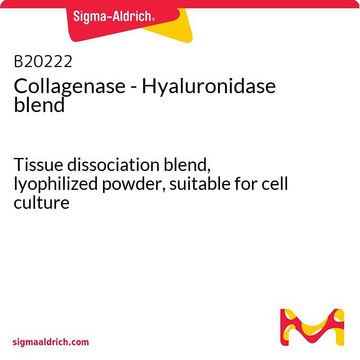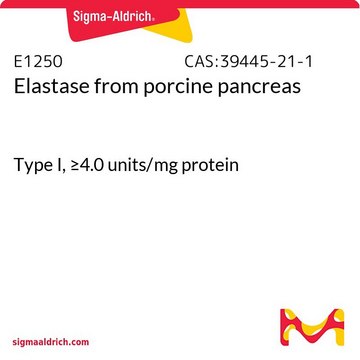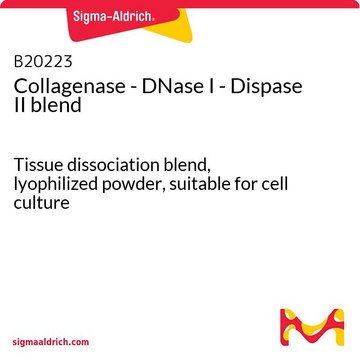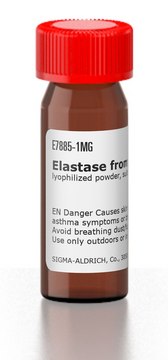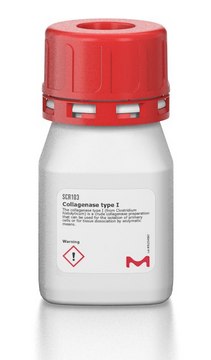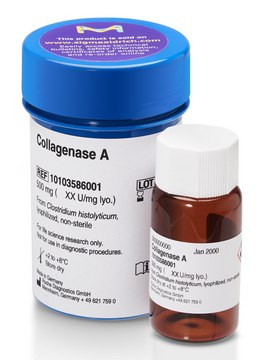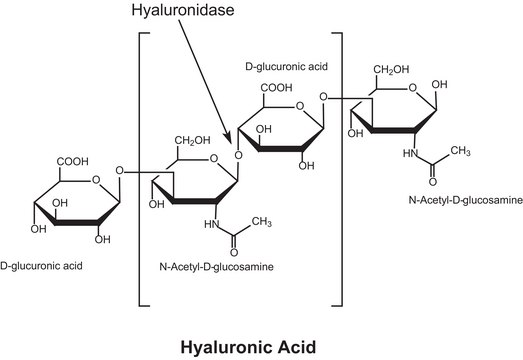B20224
Collagenase - Elastase blend
Tissue dissociation blend, lyophilized powder, suitable for cell culture
别名:
Clostridiopeptidase A, Clostridium histolyticum, Elastase, Pancreatopeptidase E, collagenase, collagenase blend, enzyme blend, tissue dissociation blend
登录查看公司和协议定价
所有图片(1)
About This Item
UNSPSC代码:
12352204
NACRES:
NA.71
推荐产品
质量水平
方案
(enzymatic)
表单
lyophilized powder
浓度
1 mg/mL (Collagenase)
技术
cell culture | mammalian: suitable
运输
dry ice
储存温度
-10 to -25°C
一般描述
The Collagenase-Elastase blend is a tissue dissociation enzyme cocktail for cell isolation. The tissue dissociation process consists in the release of functional and viable cells from animal tissue, with minimal impact on the cell’s viability. The main reagent used for the tissue dissociation process is Collagenase. Collagenases are enzymes that break down the native collagen that holds animal tissues together. The second enzyme found in our blend is Elastase: a serine protease that also hydrolyzes amides and esters. It is produced in the pancreas as an inactive zymogen and activated in the duodenum by trypsin. While elastase will hydrolyze a wide variety of protein substrates, it is unique among proteases in its ability to hydrolyze native elastin, a substrate not attacked by trypsin, chymotrypsin or pepsin. Elastin, a matrix component of tissues involved in stretching processes, is found in highest concentrations in the elastic fibers of connective tissues. Elastase is frequently used to dissociate tissues which contain extensive intercellular fiber networks. For this purpose, it is usually used with other enzymes such as collagenase, trypsin, and chymotrypsin. Elastase is the enzyme of choice for the isolation of Type II cells from the lung.
生化/生理作用
Collagenase: Effective release of cells from tissue requires the action of collagenase enzymes. Collagenase is activated by four-gram atom calcium (Ca2+) per mole enzyme. The pH optimum is 6.3-8.8. The enzyme is typically used to digest the connective components in tissue samples to liberate individual cells. Collagenase treatment can cause some cells to die. Typically, concentrations varying from 0.1 to 5 mg/mL are used for digestion. The duration of reaction varies from 15 minutes to several hours and yields satisfactory cell dissociation without causing too much cell death. Elastase: hydrolyses elastin, the specific protein of elastic fibers, and digests hemoglobin, casein and fibrin. It cleaves protein at the carboxyl side of small hydrophobic amino acids such as Ile, Gly, Ala, Ser, Val, and Leu. The enzyme also hydrolyzes amides and esters such as N-Benzoyl-L-alanine methyl ester. The pH optimum is found to be 8.0-8.5. It does not require any activator, but it is inhibited by diisopropyl fluorophosphate, phenylmethanesulfonyl fluoride, α2-macroglobulin, α1-antitrypsin, sulfonyl fluorides and p-dinitrophenyl diethylphosphate and high salt concentrations. It cleaves protein at the carboxyl side of small hydrophobic amino acids such as Ile, Gly, Ala, Ser, Val, and Leu. The enzyme also hydrolyzes amides and esters such as N-Benzoyl-L-alanine methyl ester.
制备说明
For a working concentration of: Collagenase of 1 mg/ml, Elastase 3 units/ml, reconstitute the lyophilized powder with 10 ml of Hank’s Balanced Salt solution with sodium bicarbonate, without phenol red, calcium chloride and magnesium sulfate (#H6648).
警示用语:
Danger
危险分类
Eye Irrit. 2 - Resp. Sens. 1 - Skin Irrit. 2 - STOT SE 3
靶器官
Respiratory system
储存分类代码
11 - Combustible Solids
WGK
WGK 3
法规信息
新产品
历史批次信息供参考:
商品
Discover pre-mixed collagenase enzyme blends with DNase I, Dispase II, Elastase, and Hyaluronidase and gently dissociate animal tissues in vitro.
我们的科学家团队拥有各种研究领域经验,包括生命科学、材料科学、化学合成、色谱、分析及许多其他领域.
联系技术服务部门
